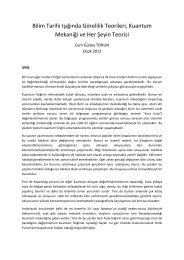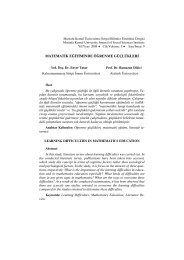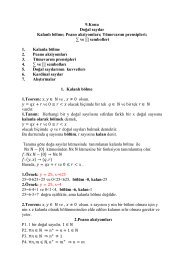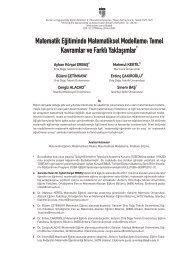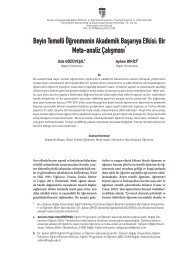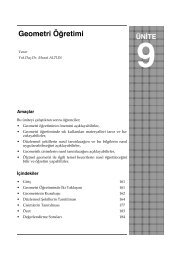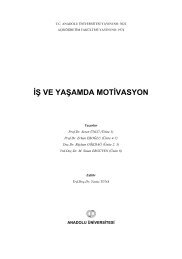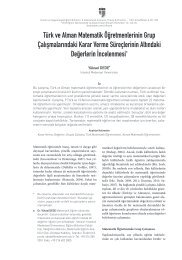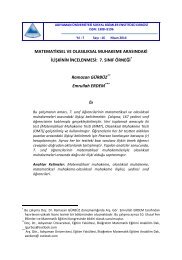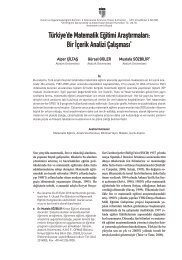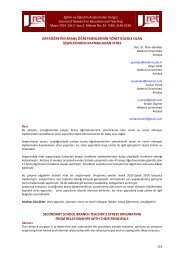noteworthy to mention that multilingualism leads to characteristics different frombilingualism at the individual, sociolinguistic, and educational levels (Cenoz & Gorter, 2005).1.3. Definition of Language Learning StrategiesMany variables as affective, social style or psychological characteristics can contributeto the success of a language learner, language learning strategies are different from them asthey are behaviors and thought processes used by a learner in the process of learning (Wenden& Rubin, 1987). Also called learning skills, learning-to-learn skill, thinking skill or problemskill,Oxford (1990) defined language learning strategies as “steps taken by students toenhance their own learning” (p. 1). Studies on these strategies initially worked on theidentification of the strategies good and successful language learners do to learn a language.These studies concluded that strategies have not only an impact on the proficiency and selfconfidencelevel but also on the effectiveness in using a second language based on thefrequency and types of strategies (Psaltou-Joycey & Kantaridou, 2009; Purdie & Oliver,1999). In a similar vein, Gardner and McIntyer (1993) suggest that several factors determinesecond language proficiency and that language learning strategies is one of them.Various classifications of language learning strategies have been purposed, but one ofthe most know classification has been done by Oxford (1990) dividing the strategies intodirect and indirect strategies. Direct strategies deal with the new language working with thelanguage itself; while indirect strategies are responsible for the general management oflearning. These categories are further divided into three subcategories each. The directstrategies include memory, cognitive and compensation strategies (see Figure 1 taken fromOxford, 1990, p.16). When examined individually, memory strategies are strategies used to“enable learners to store verbal material and then retrieve it when needed for communication”(Oxford, 1990, p.39); while cognitive strategies include various functions such as transferring,recombining and analyzing. The third set of strategies of the direct strategies is thecompensation strategies which aid language learners in using “the new language for eithercomprehension or production despite limitations in knowledge” (Oxford, 1990, p.47). As theyinclude guessing and overcoming limitations, they compensate for the insufficient grammarstructures and vocabulary items.On the other hand; the indirect strategies comprises of metacognitive, affective andsocial strategies. Metacognitive strategies are responsible for the coordination andorganization of the learning process which includes arranging and planning learning.60
Affective strategies are linked to emotions, beliefs and attitudes which can range from anxietyto excessive self-confidence and the social strategies focus on the effectiveness of languageuse in conversations with others.Figure 1. Diagram of the Strategy System: Overview_____________________________________________________________________________________________________________________________________________________________________This perspective has been the tool of many researchers investigating strategy use ofmono- and bilinguals, few researchers have focused on multilinguals’ use of strategiescomparing o bilinguals. As mentioned before, one of the differences between bilingual andmultilingual learners is the amount in language learning experience and the experience ofmultilinguals consciously learning a language which prompted the idea that multilinguallearners make use of different language learning strategies. The prior experience is thought tocause a “catalytic or speed up effect” purposed by Herdina and Jessner (2002, p. 68) which isonly viable in a context with at least three languages.Kemp (2007) conducted a study on the use of grammar strategies of multilinguallearners and hypothesized that multilinguals’ “use of strategies may increase in number,frequency, complexity and appropriateness [...]” (p. 243). Her study included 114 participantswhose number of language acquisition range from two to twelve. She made use of a set of 40grammar strategies, which she based on the strategies recommended by textbooks or adaptedfrom Oxford’s Strategy Inventory for Language Learning, and questions on other strategiesused. The results showed that there is a positive correlation between the number of languagesknown and grammar strategies used. More specifically, she concluded that the number ofgrammar strategies increases as the number of languages increases.Psaltou-Joycey and Kantaridou (2009) obtained similar results in her study in which1555 undergraduates with different languages as their second and/or third language took part.61
- Page 1 and 2:
ISSN: 2146-7676UFUK ÜNİVERSİTES
- Page 3 and 4:
UFUK ÜNİVERSİTESİSOSYAL BİLİM
- Page 5 and 6:
SUNUŞDergimizin 2014 yılı ilk sa
- Page 7 and 8:
A NEED-BASED EVALUATIONOF A PREPARA
- Page 9 and 10: In the literature on language teach
- Page 11 and 12: focus teaching on this. Accordingly
- Page 13: International Relations) were 20 (7
- Page 16 and 17: questionnaire in their English-medi
- Page 18 and 19: REFERENCESAlagözlü, N. K. (1984).
- Page 20 and 21: APPENDIX A1 STUDENT QUESTIONNAIRE
- Page 23 and 24: 24. Converting short notes into
- Page 27 and 28: The Role Of Gender On University St
- Page 29 and 30: (Johnson 2001; Türküm, 2005). Joh
- Page 31 and 32: Table 1 : Means and Standard Deviat
- Page 33 and 34: 2.3 ProcedureEthical permission to
- Page 35 and 36: age and attitude toward help seekin
- Page 37 and 38: Economics and Administrative Scienc
- Page 39 and 40: REFERENCESAddis, M. E., & Mahalik,
- Page 41 and 42: Koydemir-Özden, S. (2010). Self-as
- Page 43 and 44: LİSE ÖĞRENCİLERİNİN MESLEKİ
- Page 45 and 46: göre mesleki bakımdan daha önce
- Page 47 and 48: Araştırmanın amacıMesleki olgun
- Page 49 and 50: Tablo 1: Lise Öğrencilerinin Mesl
- Page 51 and 52: Lise öğrencilerinin karar verme s
- Page 53 and 54: KAYNAKÇA Acıbozlar, Ö. (2006). Y
- Page 55: Oğuz, Ö. (2008). Lise öğrencile
- Page 58 and 59: 1. IntroductionDifferent from the p
- Page 62 and 63: The findings indicate that multilin
- Page 64 and 65: Table 1. Descriptives statistics fo
- Page 66 and 67: overall six factor structure which
- Page 68 and 69: wider variety of strategies with a
- Page 70 and 71: inclusion of instructors who are no
- Page 72 and 73: Gardner, R. C., & MacIntyre, P. D.
- Page 74 and 75: AppendicesAppendix A- English Profi
- Page 77 and 78: ELT Student Teachers’ Evaluations
- Page 79 and 80: Reflective Teaching in TurkeyIn Tur
- Page 81 and 82: Table 1: Reliability Analysis o
- Page 83 and 84: Table 4: Mean and standard dev
- Page 85 and 86: Table 9: Mean and standard dev
- Page 87 and 88: ReferencesAkbari, R. (2007). Reflec
- Page 89: Pollard, A. & Triggs, P. (1997) Ref
- Page 92 and 93: 1. GİRİŞEğitim ve program geli
- Page 94 and 95: Genelgeçer tek bir bilimsel sürec
- Page 96 and 97: Program geliştirmedeki yenilikleri
- Page 98 and 99: -Elde ettiği sonuçlardan hareket
- Page 100 and 101: “İnternet Üzerinden Öğrenme
- Page 102 and 103: de sınıf içi dersler de öğrenm
- Page 104 and 105: teknik ve pedagojik uzmanlar gerekt
- Page 106 and 107: 3. Proje ekibinin kurulması4. Plan
- Page 108 and 109: KAYNAKÇABigdoli, H. (2004). The In
- Page 110 and 111:
110
- Page 112 and 113:
Hiçbir öğrenci bir diğeriyle ay
- Page 114 and 115:
İçerik sınıfta nelerin öğreti
- Page 116 and 117:
(MEB, 2006; Tomlinson, 2005). Ek ol
- Page 118 and 119:
- Öğrencilerden gereksinim duyduk
- Page 120 and 121:
desteklerine gereksinim duydukları
- Page 122 and 123:
KAYNAKÇAAlberto P. A, ve Troutman
- Page 124 and 125:
124
- Page 126 and 127:
1.GİRİŞBuradaki araştırma OECD
- Page 128 and 129:
öğretilenleri almışlar mı diye
- Page 130 and 131:
edileceğini araştırmaz, ancak bu
- Page 132 and 133:
yaşarlar: Çok fazla sayıda koşu
- Page 134 and 135:
• Birincil Stratejiler ve Destek
- Page 136 and 137:
ir dönemdir. Özellikle artan yaş
- Page 138 and 139:
2. Hipotez: Öğretmenlerin coğraf
- Page 140 and 141:
Tablo 7 Öğretmenlerin Coğrafi
- Page 142 and 143:
stratejileri”ne yönelik bilişse
- Page 144 and 145:
sonuçları χ 2 (12, N =407) = 13,
- Page 146 and 147:
sebebiyet verir. Bunun önemli bir
- Page 148 and 149:
KAYNAKÇAArtelt, C., Stanat, P., Sc
- Page 150 and 151:
Lieteratur. 10. Sonderheft: Lesesoz
- Page 152 and 153:
YAYIM ALANI, YAZIM KURALLARI ve YAZ
- Page 154:
• Birebir alımlar “…” İş





